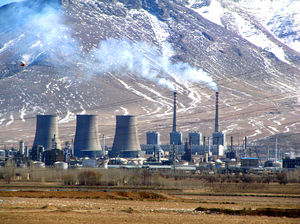Combined cycle gas plant: Difference between revisions
m (1 revision imported) |
energy>Jmdonev No edit summary |
||
| Line 1: | Line 1: | ||
[[Category:Done | [[Category:Done 2020-02-29]] | ||
[[File:Shazand_Combined-cycle_power_plant.JPG|300px|thumb|Figure 1. Combined cycle gas plant in Iran.<ref>Wikimedia Commons [Online], Available: http://upload.wikimedia.org/wikipedia/commons/f/fd/Shazand_Combined-cycle_power_plant.JPG</ref>]] | [[File:Shazand_Combined-cycle_power_plant.JPG|300px|thumb|Figure 1. Combined cycle gas plant in Iran.<ref>Wikimedia Commons [Online], Available: http://upload.wikimedia.org/wikipedia/commons/f/fd/Shazand_Combined-cycle_power_plant.JPG</ref>]] | ||
<onlyinclude>'''Combined cycle gas plants''' are a type of [[natural gas power plant]] used to [[generate electricity]], consisting of a [[simple cycle gas plant]] in combination with a second [[external heat engine|steam engine]] that uses the [[Rankine cycle]].</onlyinclude> The hot exhaust | <onlyinclude>'''Combined cycle gas plants''' are a type of [[natural gas power plant]] used to [[generate electricity]], consisting of a [[simple cycle gas plant]] in combination with a second [[external heat engine|steam engine]] that uses the [[Rankine cycle]].</onlyinclude> The hot [[exhaust gas]]es from the initial [[gas turbine]] are sent to the steam engine, and the [[heat]] from them is used to generate [[steam]]. This steam can then expand through another [[turbine]], generating even more [[electricity]] and increasing the plant's overall [[efficiency]]. The efficiency of these plants can be as great as 55%<ref name=ieso>IESO, ''Natural Gas - Simple/Combined Cycle Generation'' [Online], Available: http://www.powerauthority.on.ca/current-electricity-contracts/sc-cc</ref>, but the [[Dispatchable source of electricity#Dispatch times|dispatch times]] tend to be slower than simple cycle [[natural gas]] plants. The combined cycle typically has an increased cost. The EIA estimated that for a simple cycle plant the cost is about US$389/[[watt|kW]], whereas combined cycle plants are US$500 – 550/kW.<ref>Paul Breeze. (2005) ''Power Generation Technologies'' [Online Book], Available: https://books.google.co.uk/books?id=D9qSDgTbRZoC&pg=PA59&dq=%22Simple+cycle+combustion+turbine%22&hl=en&sa=X&ei=8A4sUYaND4vA9QSSqIDIDw#v=onepage&q=%22Simple%20cycle%20combustion%20turbine%22&f=false</ref> | ||
==Operation== | ==Operation== | ||
The first part of the plant operates by use of a gas turbine and the details can be explored on its [[gas turbine|page]]. | The first part of the plant operates by use of a gas turbine and the details can be explored on its [[gas turbine|page here]]. Essentially, it works by compressing air, injecting [[fuel]] and [[Combustion|igniting the mixture]], which expands through the turbine causing it to spin. This turbine is connected to a [[generator]], which then causes electricity to flow. This process creates hot exhaust gases, which are typically dispelled in a simple cycle plant (releasing [[waste heat]]). | ||
The exhaust gases are made to flow towards the next unit, called the '''heat recovery steam generator''' (HRSG).<ref name=wart>Wartsila, ''Combined Cycle Plant for Power Generation: Introduction'' [Online], Available: http://www.wartsila.com/power-plants/learning-center/technical-comparisons/combined-cycle-plant-for-power-generation-introduction</ref> The HRSG is essentially a [[heat exchanger]], in which the hot gases [[boiling point|boil]] pre-heat water into steam. The ''steam then expands through a turbine'', generating electricity. Once the steam has passed through, it condenses and is recycled through. | The exhaust gases are made to flow towards the next unit, called the '''heat recovery steam generator''' (HRSG).<ref name=wart>Wartsila, ''Combined Cycle Plant for Power Generation: Introduction'' [Online], Available: http://www.wartsila.com/power-plants/learning-center/technical-comparisons/combined-cycle-plant-for-power-generation-introduction</ref> The HRSG is essentially a [[heat exchanger]], in which the [[heat]] from the hot gases is used to [[boiling point|boil]] pre-heat [[water]] into [[steam]]. The ''steam then expands through a turbine'', generating electricity. Once the steam has passed through, it [[condensation|condenses]] and is recycled through. | ||
A short video from the Tennessee Valley Authority<ref>Taken from 'http://www.tva.gov/power/comb_cycle_video.htm', accessed June 12th, 2015. This video is used under creative commons license found here: https://en.wikipedia.org/wiki/File:Combined_cycle_animation.ogv (accessed June 12th, 2015 as well).</ref> visualizing the process can be seen below: | A short video from the Tennessee Valley Authority<ref>Taken from 'http://www.tva.gov/power/comb_cycle_video.htm', accessed June 12th, 2015. This video is used under creative commons license found here: https://en.wikipedia.org/wiki/File:Combined_cycle_animation.ogv (accessed June 12th, 2015 as well).</ref> visualizing the process can be seen below: | ||
Revision as of 04:13, 6 March 2020

Combined cycle gas plants are a type of natural gas power plant used to generate electricity, consisting of a simple cycle gas plant in combination with a second steam engine that uses the Rankine cycle. The hot exhaust gases from the initial gas turbine are sent to the steam engine, and the heat from them is used to generate steam. This steam can then expand through another turbine, generating even more electricity and increasing the plant's overall efficiency. The efficiency of these plants can be as great as 55%[2], but the dispatch times tend to be slower than simple cycle natural gas plants. The combined cycle typically has an increased cost. The EIA estimated that for a simple cycle plant the cost is about US$389/kW, whereas combined cycle plants are US$500 – 550/kW.[3]
Operation
The first part of the plant operates by use of a gas turbine and the details can be explored on its page here. Essentially, it works by compressing air, injecting fuel and igniting the mixture, which expands through the turbine causing it to spin. This turbine is connected to a generator, which then causes electricity to flow. This process creates hot exhaust gases, which are typically dispelled in a simple cycle plant (releasing waste heat).
The exhaust gases are made to flow towards the next unit, called the heat recovery steam generator (HRSG).[4] The HRSG is essentially a heat exchanger, in which the heat from the hot gases is used to boil pre-heat water into steam. The steam then expands through a turbine, generating electricity. Once the steam has passed through, it condenses and is recycled through.
A short video from the Tennessee Valley Authority[5] visualizing the process can be seen below:
For Further Reading
References
- ↑ Wikimedia Commons [Online], Available: http://upload.wikimedia.org/wikipedia/commons/f/fd/Shazand_Combined-cycle_power_plant.JPG
- ↑ IESO, Natural Gas - Simple/Combined Cycle Generation [Online], Available: http://www.powerauthority.on.ca/current-electricity-contracts/sc-cc
- ↑ Paul Breeze. (2005) Power Generation Technologies [Online Book], Available: https://books.google.co.uk/books?id=D9qSDgTbRZoC&pg=PA59&dq=%22Simple+cycle+combustion+turbine%22&hl=en&sa=X&ei=8A4sUYaND4vA9QSSqIDIDw#v=onepage&q=%22Simple%20cycle%20combustion%20turbine%22&f=false
- ↑ Wartsila, Combined Cycle Plant for Power Generation: Introduction [Online], Available: http://www.wartsila.com/power-plants/learning-center/technical-comparisons/combined-cycle-plant-for-power-generation-introduction
- ↑ Taken from 'http://www.tva.gov/power/comb_cycle_video.htm', accessed June 12th, 2015. This video is used under creative commons license found here: https://en.wikipedia.org/wiki/File:Combined_cycle_animation.ogv (accessed June 12th, 2015 as well).

